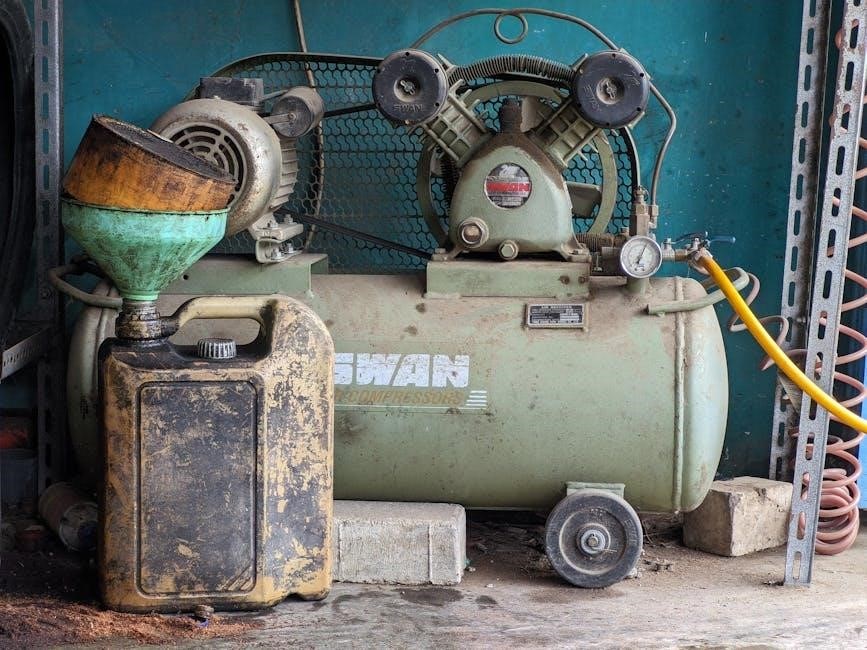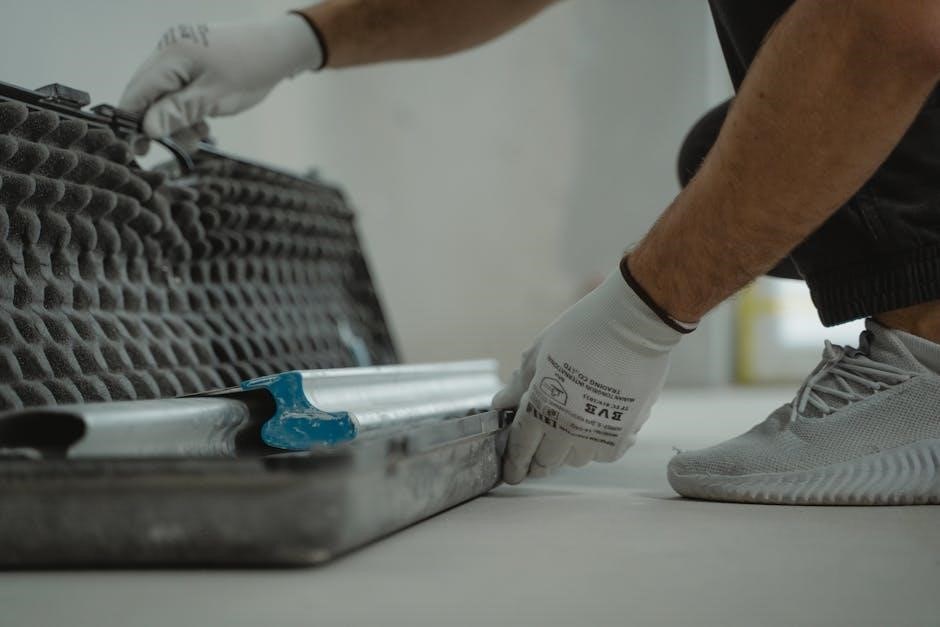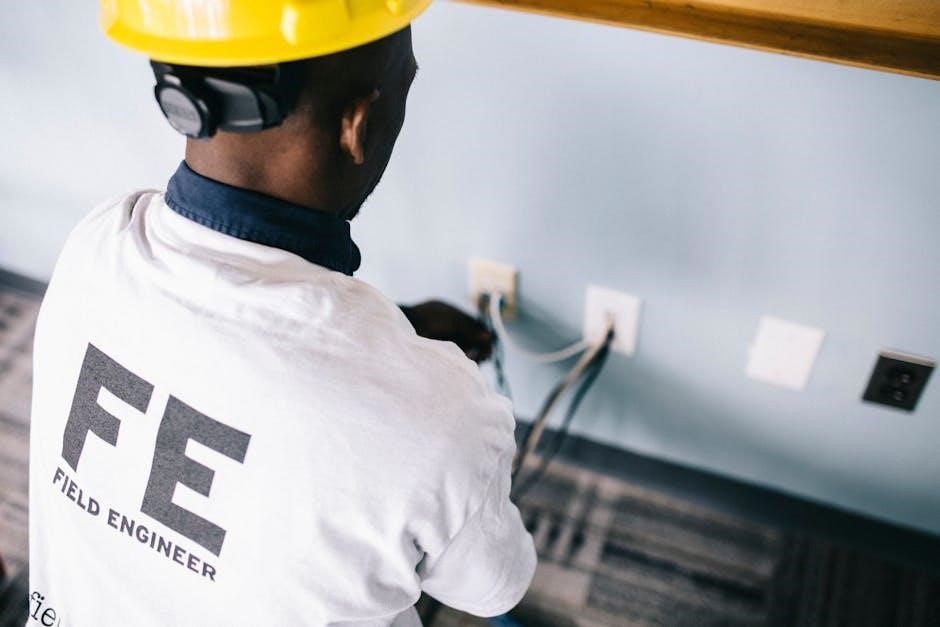Manually engaging an AC compressor involves bypassing automatic controls to activate the compressor clutch for troubleshooting or repair purposes‚ useful when the system fails to start normally.
Understanding the Basics of AC Compressors
The AC compressor is the core of the air conditioning system‚ responsible for compressing refrigerant to facilitate heat transfer. It operates via a clutch that engages when cooling is needed; If the compressor fails to engage‚ issues like low refrigerant levels‚ electrical malfunctions‚ or clutch problems may be the cause. Understanding these components and their interactions is essential for effective troubleshooting and manual engagement. Proper diagnosis involves checking electrical connections‚ capacitors‚ and refrigerant levels to identify and address the root cause. This foundational knowledge helps in safely and efficiently resolving compressor engagement issues‚ ensuring optimal AC performance. Regular maintenance and awareness of common problems can prevent future occurrences and extend the system’s lifespan.
Why Manual Engagement Might Be Necessary
Manual engagement of the AC compressor may be necessary when the system fails to activate automatically‚ often due to electrical or mechanical issues. This method bypasses the automatic controls‚ allowing the compressor to run for diagnostic purposes. Common scenarios include faulty sensors‚ low refrigerant levels‚ or a malfunctioning clutch. Manual engagement helps technicians identify if the compressor itself is functional or if the issue lies elsewhere. It is a temporary solution to assess system performance and determine the root cause of the problem. This approach is particularly useful for troubleshooting in the field‚ where immediate repairs may not be feasible. However‚ it should be performed with caution and only by individuals with the necessary technical knowledge to avoid further damage to the system.

Preparing for Manual Engagement
Before manually engaging the AC compressor‚ ensure you have the necessary tools and materials‚ such as a jump starter‚ multimeter‚ and safety gear. Verify the system’s electrical connections and refrigerant levels to identify potential issues. Always follow proper safety precautions to avoid electrical shocks or system damage. Gather a repair manual or online guide for step-by-step instructions. Understand that manual engagement is typically a diagnostic step to test compressor functionality and identify underlying problems. Proceed with caution to prevent further damage or hazards.
Tools and Materials Needed
To manually engage the AC compressor‚ you will need specific tools and materials. A multimeter is essential for checking electrical connections and voltage levels. A jump starter or battery pack can provide the necessary power to engage the compressor clutch. Pliers‚ screwdrivers‚ and wrenches are useful for accessing and manipulating the electrical connectors. Safety gear‚ such as gloves and safety glasses‚ is crucial to protect yourself from potential hazards. Additionally‚ a repair manual or online guide specific to your AC compressor model can provide detailed instructions. Ensure you have a clean‚ well-lit workspace and access to refrigerant gauges if needed. Properly gathering these tools beforehand will help streamline the process and minimize risks. Always double-check your tools and materials to ensure they are in good working condition before proceeding.
Safety Precautions Before Starting
Before manually engaging the AC compressor‚ it is crucial to take safety precautions to avoid accidents. Always disconnect the battery to prevent accidental start-ups or electrical shocks. Wear protective gear‚ including gloves and safety glasses‚ to shield yourself from potential debris or refrigerant exposure. Ensure the workspace is well-ventilated to avoid inhaling refrigerant fumes or other harmful gases. Never attempt manual engagement without first relieving system pressure‚ as this could lead to sudden releases of refrigerant or system damage. Use a refrigerant leak detector to ensure no leaks are present before starting. Additionally‚ be cautious when handling electrical components‚ as they may carry high voltage. If unsure about any step‚ consult a professional to avoid risks. Safety should always be your top priority when working with automotive systems.

Understanding the AC Compressor System
The AC compressor system includes the compressor‚ clutch‚ and associated electrical and refrigerant components. It compresses refrigerant to cool the vehicle’s cabin air. The clutch engages the compressor when cooling is needed‚ typically controlled by the car’s computer. Proper operation depends on adequate refrigerant levels‚ functioning electrical connections‚ and a healthy clutch. Manual engagement may be necessary if the compressor fails to activate automatically‚ often due to electrical issues or low refrigerant. Safety precautions are essential when intervening manually to prevent damage or injury. Always consult professional guidance if unsure‚ as improper handling can lead to system damage or safety risks.
Components of the AC Compressor
The AC compressor consists of several key components essential for its operation. The compressor itself is the heart of the system‚ responsible for compressing refrigerant. The clutch is a critical part that engages and disengages the compressor from the engine’s serpentine belt. The pulley is attached to the compressor and connected to the belt‚ providing the mechanical power needed to operate. Inside the compressor‚ there are coils and valves that manage the flow and pressure of the refrigerant. Additionally‚ the system includes electrical connectors and switches that control the clutch’s engagement. Finally‚ the control module or AC controller oversees the entire system‚ ensuring proper operation based on inputs like cabin temperature and pressure sensors. Understanding these components is vital for diagnosing issues and performing manual engagement safely and effectively.
How the Compressor Engages Normally
In normal operation‚ the AC compressor engages through an automatic process controlled by the vehicle’s electrical system. When the air conditioning is turned on‚ the control module sends an electrical signal to the compressor clutch coil. This coil energizes‚ causing the clutch to engage the compressor pulley with the engine’s serpentine belt. The belt then drives the compressor to compress refrigerant. The engagement is typically smooth and happens without driver intervention. Sensors monitor system pressure and temperature‚ ensuring the compressor operates efficiently and safely. If the system detects low refrigerant levels or high pressure‚ it may prevent the compressor from engaging to avoid damage. This automatic process ensures optimal performance and protects the system from potential harm.

Troubleshooting Common Issues
Common issues include low refrigerant levels‚ electrical faults‚ and clutch malfunctions. Checking these areas helps diagnose and resolve engagement problems effectively‚ ensuring proper AC function.

Why the AC Compressor Might Not Be Engaging
The AC compressor may fail to engage due to low refrigerant levels‚ electrical issues‚ or a malfunctioning clutch. Low refrigerant can prevent the system from building enough pressure to activate the compressor. Electrical problems‚ such as a blown fuse‚ bad capacitor‚ or wiring issues‚ can disrupt the signal or power needed for engagement. The compressor clutch might also fail to engage if it is worn or damaged. Additionally‚ internal compressor faults‚ such as seized bearings or broken components‚ can prevent operation. Control system malfunctions‚ like faulty sensors or relays‚ may also inhibit engagement. Identifying the root cause is crucial for effective troubleshooting and repair. Regular maintenance can help prevent these issues and ensure reliable AC performance. Always check for these common problems before attempting manual engagement. Ensuring proper refrigerant levels and electrical connections is essential for smooth operation. If issues persist‚ professional assistance may be necessary to diagnose and fix underlying problems. Proper diagnosis ensures safety and prevents further damage to the system. Regular inspections can help maintain the compressor’s efficiency and longevity. Understanding these factors is key to resolving engagement issues effectively. Proper tools and knowledge are vital for safe and successful troubleshooting.
Diagnosing Electrical or Refrigerant Problems
Diagnosing electrical or refrigerant issues is crucial before manually engaging the AC compressor. Start by checking the electrical system for blown fuses‚ tripped breakers‚ or damaged wiring. Use a multimeter to test voltage at the compressor terminals. A faulty capacitor or clutch coil may also prevent engagement. For refrigerant issues‚ inspect for leaks using a UV dye kit or electronic leak detector; Low refrigerant levels can be verified with a pressure gauge during system operation. Ensure the expansion valve is not blocked‚ as this can restrict refrigerant flow. If the system has the correct refrigerant charge and no electrical faults‚ the compressor should engage normally. Always follow safety protocols when handling refrigerants and electrical components. Proper diagnosis ensures safe and effective troubleshooting. Addressing these issues is essential for reliable compressor operation and system performance. Regular inspections can help identify potential problems early‚ preventing costly repairs. Always refer to the vehicle’s service manual for specific diagnostic procedures.

Manual Engagement Process
Manually engaging the AC compressor involves using specialized tools to bypass the clutch or directly power the system. Ensure safety by disconnecting the battery first. Always follow manufacturer guidelines for proper engagement procedures. This process helps diagnose and resolve compressor issues effectively‚ ensuring optimal cooling performance and system functionality.
Step-by-Step Guide to Manually Engage the Compressor
To manually engage the AC compressor‚ start by ensuring the system is safe to work with. Disconnect the car battery to prevent any accidental starts or electrical shocks. Next‚ locate the compressor clutch and inspect it for any visible damage or wear. If the clutch is damaged‚ it may need to be replaced before proceeding. Using a wrench or pliers‚ carefully manually turn the compressor pulley to ensure it spins freely. If it does not‚ there could be internal damage requiring professional attention. For vehicles equipped with a clutchless compressor‚ you may need to bypass the clutch engagement system temporarily. Always refer to your vehicle’s repair manual for specific instructions‚ as improper engagement can lead to further damage. After manual engagement‚ reconnect the battery and test the AC system to ensure proper function.
Using a Jump Starter for Manual Engagement
Using a jump starter can be an effective method to manually engage the AC compressor‚ especially if the clutch relay or fuse has failed. To do this‚ disconnect the car battery to ensure safety. Locate the compressor clutch wire‚ typically connected to the clutch relay. Use the jump starter to apply 12V power directly to the clutch wire while grounding the other terminal. This will bypass the relay system and manually engage the compressor clutch. Once engaged‚ reconnect the battery and test the AC system to confirm proper operation. Be cautious‚ as this method is temporary and may not address the root cause of the issue. If the compressor does not engage‚ further diagnosis or professional assistance may be required to identify and repair the underlying problem.

Post-Engagement Checks
After manual engagement‚ verify the AC compressor operates smoothly‚ check for refrigerant leaks‚ and ensure all electrical connections are secure to prevent future malfunctions.
Verifying Proper Compressor Operation

After manually engaging the AC compressor‚ it’s crucial to verify its proper operation. Start by listening for unusual noises‚ such as grinding or hissing sounds‚ which could indicate internal damage. Check the system’s cooling performance by ensuring the air vents blow cold air. Use a thermometer to measure the temperature difference between the inlet and outlet of the evaporator core. A significant drop confirms the compressor is functioning correctly. Additionally‚ monitor the compressor clutch engagement—it should cycle on and off smoothly without slipping. Inspect the system’s pressure using a manifold gauge to ensure it operates within the recommended range. Finally‚ observe the dashboard for any warning lights that may indicate malfunctions. Proper operation ensures efficient cooling and prevents further issues.
Checking for Refrigerant Leaks
After manually engaging the AC compressor‚ it’s essential to check for refrigerant leaks to ensure the system operates efficiently. Start by inspecting the compressor‚ hoses‚ and connections for visible signs of damage or wear. Use a UV dye kit to detect leaks‚ as the dye illuminates under UV light‚ making even small leaks visible. Alternatively‚ an electronic leak detector can pinpoint leaks accurately. Bubbles forming on surfaces when soapy water is applied can also indicate leaks. Pay particular attention to O-rings‚ seals‚ and couplers‚ as these are common leak points. If a leak is found‚ repair it immediately to prevent refrigerant loss‚ which can lead to reduced cooling performance or system damage. Regular inspections help maintain system integrity and efficiency.

Advanced Troubleshooting Techniques
Advanced troubleshooting involves inspecting the electrical system‚ testing the compressor clutch‚ and checking the capacitor. Use a multimeter to test wiring and connections for continuity and voltage. Inspect the clutch relay and fuse to ensure they are functioning properly. Test the capacitor for capacitance and voltage rating using a capacitor tester. If the clutch doesn’t engage‚ check for worn or damaged bearings and replace them if necessary. Also‚ ensure the compressor pulley is spinning freely and not seized. These steps help identify and resolve complex issues preventing manual engagement of the AC compressor.
Inspecting the Electrical System
Inspecting the electrical system is crucial for diagnosing issues related to manual engagement of the AC compressor. Start by checking the wiring harness and connectors for any signs of damage‚ corrosion‚ or wear. Use a multimeter to test for voltage at the compressor clutch relay and control module. Ensure all fuses and circuit breakers related to the AC system are intact and functioning properly. Verify that the clutch relay is activating correctly when the AC is turned on. Also‚ inspect the compressor’s electrical terminals for clean connections and proper grounding. If any wiring or components are damaged‚ repair or replace them to restore proper electrical flow. This step ensures the compressor receives the necessary signal to engage manually or automatically.
- Check wiring harness and connectors for damage or corrosion.
- Use a multimeter to verify voltage at key electrical points.
- Inspect fuses‚ relays‚ and terminals for proper function.
- Ensure clean connections and proper grounding.
Testing the Compressor Clutch and Capacitor
Testing the compressor clutch and capacitor is essential to ensure proper manual engagement of the AC compressor. Begin by inspecting the clutch for smooth engagement. Use a multimeter to check for voltage at the clutch coil when the AC is activated. If no voltage is present‚ the clutch relay or wiring may be faulty. Next‚ examine the capacitor‚ which provides the necessary power to start the compressor. Measure its capacitance using a multimeter; a reading significantly below the specified value indicates a failed capacitor. Also‚ visually inspect for signs of swelling or leakage‚ which are clear indicators of failure. Replace any faulty components to ensure reliable operation. Proper testing helps identify issues before attempting manual engagement‚ preventing further damage to the system.
- Check clutch engagement and voltage supply using a multimeter.
- Test capacitor capacitance and inspect for physical damage.
- Replace faulty components to ensure system reliability.

Maintenance and Preventive Measures
Regular maintenance prevents AC compressor issues‚ reducing the need for manual engagement. Inspect belts‚ hoses‚ and electrical connections‚ and ensure proper refrigerant levels. Clean condenser coils and replace filters to maintain efficiency and prevent overheating. Schedule professional servicing annually to identify and address potential problems early. Consistent upkeep ensures reliable operation and extends the compressor’s lifespan.
- Inspect belts‚ hoses‚ and electrical connections regularly.
- Clean condenser coils and replace air filters.
- Check refrigerant levels and address leaks promptly.
- Schedule annual professional servicing for optimal performance.
Regular Maintenance to Avoid Manual Engagement
Preventive maintenance is crucial to avoid manual engagement of the AC compressor. Regularly inspect belts‚ hoses‚ and electrical connections for wear or damage. Ensure proper refrigerant levels and address leaks promptly to maintain system pressure. Clean condenser coils and replace air filters to enhance airflow and efficiency. Schedule annual professional servicing to identify potential issues early. Additionally‚ monitor the capacitor and clutch performance‚ as faults here can prevent automatic engagement. By maintaining these aspects‚ you reduce the need for manual intervention and ensure reliable AC operation.
- Inspect belts‚ hoses‚ and electrical connections for wear or damage.
- Ensure proper refrigerant levels and address leaks promptly.
- Clean condenser coils and replace air filters regularly.
- Monitor capacitor and clutch performance for optimal function.
- Schedule annual professional servicing for early issue detection.
Preventive Tips for AC Compressor Longevity
To ensure the AC compressor operates efficiently and lasts longer‚ adopt preventive measures. Proper installation and alignment are critical to avoid uneven wear. Regularly check and maintain the recommended refrigerant levels‚ as overcharging or undercharging can strain the system. Keep the compressor and condenser coils clean to prevent overheating. Avoid exposing the unit to extreme temperatures or contaminants. Use high-quality components and ensure all electrical connections are secure. Inspect the compressor clutch and capacitor periodically for signs of wear. Avoid overloading the system‚ and ensure proper airflow around the unit. Schedule professional inspections annually to identify and address potential issues early. These practices will help extend the lifespan of your AC compressor and reduce the likelihood of manual engagement.
- Ensure proper installation and alignment to prevent uneven wear.
- Maintain correct refrigerant levels to avoid system strain.
- Keep compressor and condenser coils clean to prevent overheating.
- Use high-quality components and secure electrical connections.
- Inspect the clutch and capacitor for signs of wear.
- Schedule annual professional inspections for early issue detection.
Manually engaging an AC compressor is a complex process that requires careful consideration and execution. While it can serve as a temporary solution to get your air conditioning system running‚ it is crucial to address the underlying issues to ensure long-term functionality. Understanding the root cause—whether it be electrical problems‚ low refrigerant levels‚ or a faulty clutch—is essential for effective troubleshooting. Safety should always be a priority‚ with proper protective gear and cautious handling of electrical and refrigerant systems. Regular maintenance‚ such as cleaning condenser coils and checking the capacitor‚ can help prevent future issues. If in doubt‚ consulting a professional is advisable to avoid further damage and ensure the system operates efficiently and safely.
Final Thoughts on Manual Engagement
Manually engaging an AC compressor can be a useful skill for car owners‚ especially when the automatic system fails. Understanding the underlying causes‚ such as electrical issues or low refrigerant levels‚ is crucial for effective troubleshooting. Checking electrical connections and ensuring proper refrigerant levels are essential first steps. If manual engagement is necessary‚ using a jumper wire on the compressor clutch can temporarily restore function‚ but safety precautions like disconnecting the battery are vital to prevent accidents. While this process can provide a temporary fix‚ addressing the root cause is essential for long-term functionality. If uncertain or uncomfortable with the process‚ seeking professional assistance is advisable to ensure safety and proper repair.
When to Seek Professional Help
While manual engagement of an AC compressor can be a temporary solution‚ there are situations where professional assistance is necessary. If the compressor fails to engage even after manual attempts or if persistent issues arise‚ consulting a certified technician is recommended. Electrical system complexities‚ such as faulty sensors or wiring‚ often require specialized tools and expertise. Additionally‚ if refrigerant leaks or internal compressor damage are suspected‚ professional diagnosis and repair are essential. Safety risks‚ such as electrical shocks or system overpressure‚ also warrant expert intervention. DIY attempts in these cases can lead to further damage or safety hazards. Always prioritize professional help when dealing with intricate or unsafe conditions to ensure proper and lasting repairs.

Be First to Comment